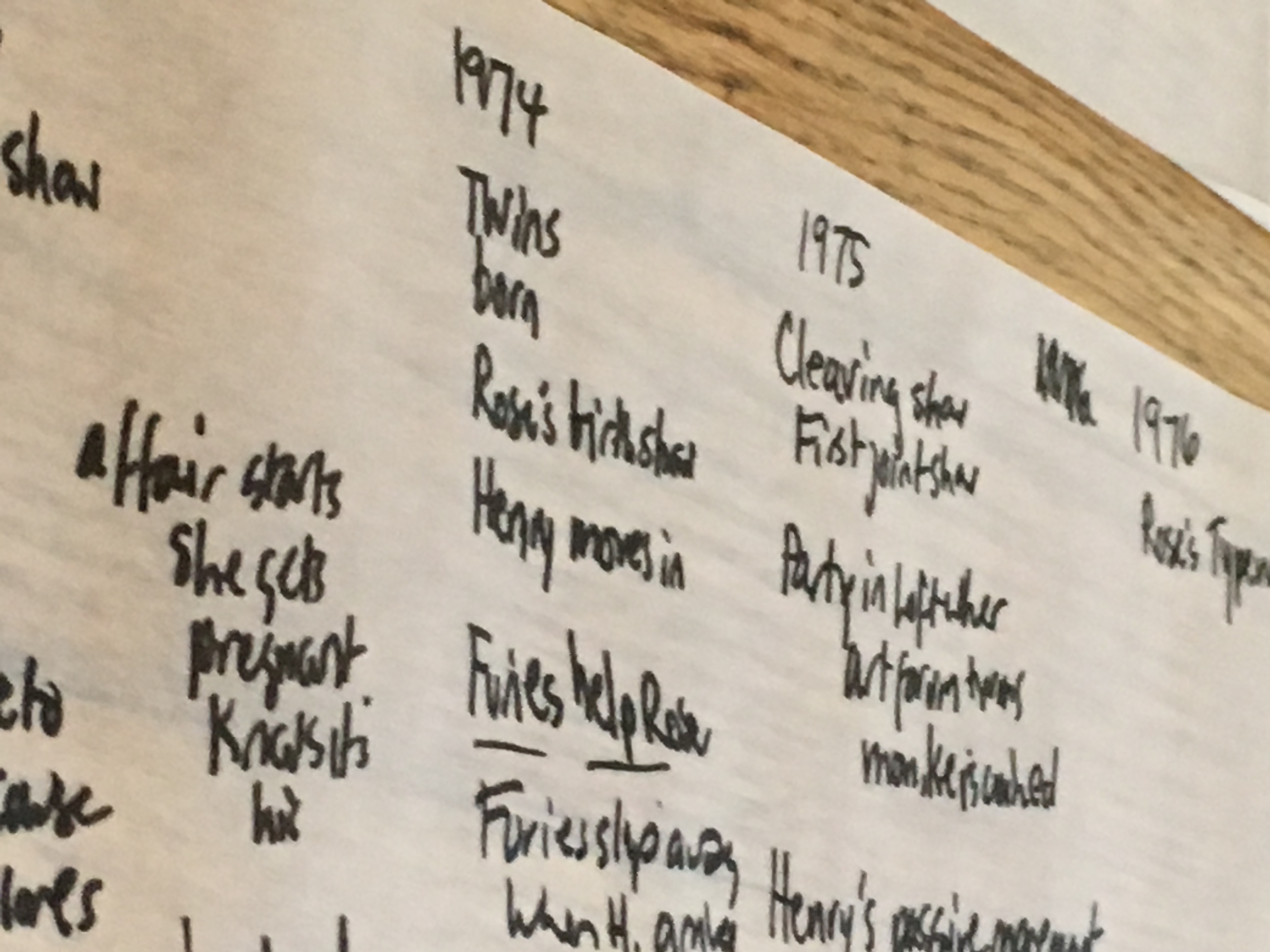
I think in words, not images, which I imagine is a form of dementia rarely studied by brain scientists—it’s a disadvantage when looking at a map or a set of architectural plans, and I have long believed it also to be a disadvantage when building the big complex geography of even the most pared-down fictional world.
When a person does not have a natural gift for “reading the map” of a world, even a fictional world one has dreamed up oneself, there is a navigator’s tool at hand, a methodology for unraveling the terrain, that I believe makes the world accessible and visual even for those of us who don’t naturally think that way. My method is a combination of focused deconstruction à la Francine Prose’s book Reading Like a Writer, and what the novelist Aaron Hamburger describes as outlining in reverse, in an article I’ve been passing out to classes every semester since it was published. Somewhere along the way, the hybrid I was making evolved into a beast all its own. I realized that I had a “trick” that every writer could use. That’s what I’m sharing here.
My method allows me to visualize what I’ve done, while remaining in the world of language—I can see shape, and I can see what I haven’t used fully, and I can see what’s been missed altogether. I can identify the unconscious symbolic decisions I made when drafting and can consider how to further deepen those choices—the gestures that might not be visible to the average reader but will be felt in terms of the story’s integrity and truth.
When I use this method as a teaching tool, I can help students see what choices an artist has made and how it affects the whole. What is hidden but can be seen; what has been left as a gap in time or action; how the author’s stance vis-à-vis the story has been carefully staged. Not only does it teach us about what other artists have done; it also reveals to us what we can do, the infinite possibilities for the way a story can be told. And why playing with those possibilities—trying different angles, removing scenes, adding them, tightening verb choices—can take a story from competent to fully realized.
So what is this magic method? It sounds simple, and that’s because it is.
Plot vs. Story is the name of the game.
Let’s say, for our purposes, that Plot is everything that ever happened in the world of the Story. Everything the author has let you know. Maybe the Story begins on a Tuesday in February, when the main character has been scalded by coffee steam at his barista job in Portland. But somewhere in the Story you learn that your character was born eight weeks early in a tent during a sudden New Mexico snowstorm, his father a nurse who carried the preemie from the mountain inside his jacket, calling an ambulance and saving everyone. That’s a fact that belongs at the beginning of your Plot chronology. Even though it’s backstory in your Story, it’s the first fact in your Plot. Does our barista go to the hospital? Or quit his job? Or soldier on? The answer is found somewhere in his Plot.
Step by step, you unwind the time of the Story and figure out what the actual detailed events are and arrange them chronologically, in Plot. I like to do this on a piece of tracing roll borrowed from my architect husband. You could use a cheap white board or write very small on a regular piece of paper. I sometimes use plain 4 x 6 file cards and lay them out on the floor, so that I can stand over them like a giant, and stare. And I love Post-it note poster-sized peel-off sheets, but they’re expensive and somehow feel precious, harder to use for first draft dissections. Later, once a project seems to be holding its shape reliably, I can better justify the expense. Honestly, each project somehow dictates how it wants to be broken apart. But for the most part, for me, the old reliable is tracing paper on a roll.

After I’ve picked out what I know of the Plot, I do the same thing for the Story—the actual told bytes of the thing, the scenes that are written—element by element. I pin the sheets up on a wall and stare at them. On the wall, the two timelines play against each other, and reveal how they connect. And where they don’t. I look for places in the chronology that don’t add up. For example, a character who has expressed awareness of an event he can’t yet know about, or a connection between two people that will deflate the oomph of a later realization. Also, places where I know an awful lot but don’t use it very well. Big blank spots in the history of my characters’ lives. Where all the heat of the Story action seems to be piling up—why, in light of everything I know, have I chosen this particular part of Plot, and are there other places in Plot where I might be able to develop tension? What have I missed? What opportunities do I see?
I also make note of symbols and themes I’ve unconsciously incorporated. Can I work them harder, add them in elsewhere to strengthen the idea, or do these ideas or things—unassuming houses near big bodies of water, the word “mossy,” or forgotten novels by forgotten women—already bear too much of a load in the narrative?
It may be helpful here to consider a published work. Look, for example, at Ian McEwan’s On Chesil Beach. Plot begins with childhood for our two main characters, and ends with them as older people, each alone, one successful and one less so. But the Story is their wedding. All the heat of Story is in their wedding night, with a less intense heat around the brief period of their courtship, which is told in flashback during the events of that single evening. Nonetheless, as often happens, the key to the story is in Plot. That’s where we learn that the promising young historian Edward is ashamed of his schoolteacher father, his impoverished background, and will always feel that he is worth less than his bride, the musical, well-bred Florence. And that’s where we learn that a much-younger Florence was, perhaps, molested by her father one evening, on a boat crossing the English Channel. McEwan deliberately makes this information easy to miss, as if it’s vestigial, skeletal, only there for the determined to discover.
The inevitability of the wedding night Story is found in that buried source material, in Plot. It is to McEwan’s everlasting credit that he knows to hold back, to keep Plot at bay in service of the most beautiful version of Story.
In my own work, I find that early drafts are almost always unwieldy versions of Plot. The shaping into Story comes over multiple versions. The more I know of Plot—who is who, and where they come from, and why they believe what they believe—the more I gain the courage to shrink its presence, to move events offstage or eliminate scenes, to restructure the passage of time. To think a little more like McEwan.
So, for example, in my current project (a novel about a young writer who “borrows” the work of an unknown and—he thinks—long-dead writer, only to discover that she is alive and well), the first strong, “oh, now I’m onto something!” draft began with twelve-year-old Milo finding the earlier writer’s book, while on vacation with his family. Call this Moment One:
1989 MILO FINDS BOOK. (FATHER DIES)
In my Story Chronology, this has always remained the earliest moment of the book. But in Plot Chronology, time unwound, there is the entire story of Joyce, the writer of the original book. When Milo is 12, in 1989, Joyce is in her 50s, has survived a childhood of incredible difficulty, and is in Maine, working as a bookkeeper and trying to live day to day, as quietly as she can.
So the Plot Chronology begins with Joyce, doesn’t it? Not with my supposed main character, Milo.
1950 JOYCE BORN, JOYCE’S CHILDHOOD, 1966 JOYCE LEAVES HOME, 1972 JOYCE PUBLISHES MEMOIR AS NOVEL (RICHARD NIXON RESIGNS), 1972 JOYCE MOVES TO MAINE, 1976 JOYCE MARRIES, 1977 JOYCE DIVORCES, 2000 JOYCE TAKES POETRY CLASS, 2010 JOYCE BEGINS TO TEACH, 2017 JOYCE LEARNS ABOUT MILO.
Where do Milo and Joyce’s lives share Plot Time? From about 1989, Joyce is the most important person in Milo’s world, but she knows nothing about him. In 2014, when Milo shows up at a writing conference in Southampton, their paths become destined to cross. As I stared at this Plot chronology, I began to see that Story began there, at the moment when the collision of my two characters became inevitable. It reminded me of Patricia Highsmith’s Strangers on a Train, a novel I love, in which a chance meeting joins two characters in a destructive, inescapable duel. Criss-cross, I thought. How can I use that idea in Story to create tension? I began to reveal Joyce’s Plot earlier in Story, but also, I moved the events of Chapter Two to Chapter One, so that the entire book began at the writers’ conference.
And then Story vs. Plot once again did its magic. In this new version, the Story began with a zing of energy. But on the revised wall of Story vs. Plot, I now saw that Milo had no known life from the age of 12 until the age of 17. His Plot line was quiet. For him to develop into the adult I needed him to be, he had to have history in adolescence. There needed to be Story, a trajectory. And here, as I began to map out Milo’s high school character, something wonderful happened. I saw that beginning the Story at the writers’ conference was almost right. But that my earlier start, with Milo’s finding of the book, had more heft. So I returned to it, but with my Plot knowledge, was able to refer to the future, to the conference itself, in paragraph one, letting the reader know where we were going. Plot was in there, but lightly. Story was winning.
Recently, I did this process with a student in Stony Brook Southampton’s post-MFA novel-polishing program BookEnds, a program that Meg Wolitzer and I helm together. Mira had organized her novel (about the children of two driven artists) inside a framing story. When we unwound her Story, we were impressed with the way backstory and current day story were twinning together. But when we unwound her Plot chronology, we saw that the framing story didn’t have enough tension on its own to steer the book. Will Mira add narrative elements to her frame story? Or will she recut and restructure the novel to unfold chronologically? Or will she run the book backwards in time? Those are the questions she can now answer on her own terms, based on the book she had drafted, the junctures and dis-junctures discovered in our exercise.

This process sounds straightforward and easy, doesn’t it? Throw two timelines up on a wall and let them show you where there is synchronicity and where there are holes. It’s harder work than it sounds: Laborious to tease out the elements and difficult to make sense of them. That’s why it can be helpful to do with a friend or mentor. But the GPS-approved route through the terrain reveals itself every time.
This exercise never fails to reveal to me something about my work that I haven’t seen. It never fails to reveal to me something about my students’ work. It never fails to reveal to me some secret of a published work, some key to deeper understanding. It’s a way to see things I’m otherwise blind to, a process for finding my way through the topography of my novel. Let map-readers have their maps; this is what I have.
*
Susan Scarf Merrell is director of the Southampton Writers Conference, program director of the BookEnds post-MFA novel-polishing program, and a professor in the MFA in Creative Writing & Literature at Stony Brook Southampton. She is the author, most recently, of SHIRLEY: A Novel, which was selected as one of the top fifty novels of the year by The Washington Post and has been optioned by HBO. Merrell is also author of the non-fiction work, The Accidental Bond: How Sibling Connections Influence Adult Relationships, and the novel A Member of the Family. Articles, reviews and short stories appear most recently in The Washington Post, The Los Angeles Review of Books, East Magazine, Fifth Wednesday, and on the website Electric Literature.
Photos by author.




